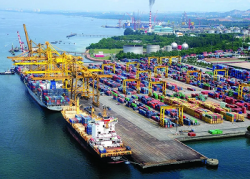East-west rates diverge as transpac spots hold while Asia-Europe keeps falling
Container spot freight rates on the main east-west trades diverged this week after a series of rate hikes held on the transpacific trades, but failed to arrest the continued declines seen on Asia-Europe sailings.
This week’s World Container Index (WCI) from Drewry saw both the Shanghai-Los Angeles and Shanghai-New York legs register week-on-week spot rate increases, while this week’s Shanghai Containerised Freight Index (SCFI), which records quoted rates, suggested that further pricing gains ought to be expected next week.
Notwithstanding the noise around US tariffs, this week’s WCI Shanghai-Los Angeles recorded spot rate increased 10% week on week, to reach $2,726 per 40ft, thus reversing uninterrupted rate declines seen on the route since 9 January, when it stood at $5,476 per 40ft
Meanwhile, the SCFI’s Shanghai-US west coast base port route increased 6% week on week, to today stand at $2,313 per 40ft – last week, the SCFI rate on the same route grew 16% week on week, while the WCI’s Shanghai-Los Angeles shed 6%, indicating the spread between the two indices can be extremely volatile.
The WCI’s Shanghai-New York’s spot rate increased 8% week on week, to $3,894 per 40ft – it too has been continually losing ground since the 9 January high point of $7,085 per 40ft.
This SCFI’s Shanghai-US east coast base port grew 8.5% to $2,580 per 40ft.
Drewry attributed this week’s rebounding rates to a combination of reduced capacity and 1 April general rate increases introduced by carriers.
“Rate stabilisation may be influenced by GRIs and MSC’s blanked sailings, though capacity adjustments vary across alliances.
“Of 57 planned cancellations [globally] over the next five weeks, 30 are on transpacific routes, with 15 from MSC and the Ocean Alliance, while Gemini has yet to announce any,” it explained.
Of course, demand has also remained strong from US importers keen to get goods into the country before new tariffs come into force, although that will likely have ramifications later, said Freightos head analyst Judah Levine.
“With the reciprocal tariffs not being applied to goods loaded before 9 April, we may see a very brief scramble that will push container rates and demand up for the next few days.
“After that though, many importers who’ve built up inventory are likely to be able to reduce or pause orders and shipments until the tariff dust settles.
“This move will see container volumes and rates drop, possibly significantly, soon and could be one factor that will cause a very subdued peak season period this year,” he explained.
One large UK forwarder told that some of its major shippers had “requested that all US-bound shipments on both transatlantic and transpacific be halted until they ask, ‘what the fuck’s going on’”.
Meanwhile, spot rates remained weak on the Asia-Europe trades with the WCI’s Shanghai-Rotterdam leg shedding 3% week on week, to end at $21,304 per 40ft, while the SCFI’s Shanghai-North Europe base port was essentially flat, at $2,672 per40ft.
The WCI’s Shanghai-Genoa leg was down 4% week on week, to $3,031 per 40ft and the SCFI reading for the route declined 2.5%, to $4,056 per 40ft.
Overcapacity on both trades appears to be a growing problem – while rates were always expected to decline post-Chinese New Year, the steepness of the descent has surprised analysts.
“Container freight rates have a strong seasonal tendency to weaken in the period following Chinese New Year. In 2025, however, the decline in spot rates is significantly more negative, than what can be explained by just seasonality,” said Sea-Intelligence Consulting chief executive Alan Murphy.
“This could be the result of an aggressive commercial price war between shipping lines, potentially due to the switch-over to the new alliances, a weakening of the supply/demand balance, or a combination of both,” he added.
According to its data, in the eight weeks since Chinese New Year, capacity on Asia-North Europe has grown 27% year on year.
“Especially for Asia-Europe, it is clear that a highly significant capacity growth is a key parameter in explaining the current spot rate weakness,” Mr Murphy said.

